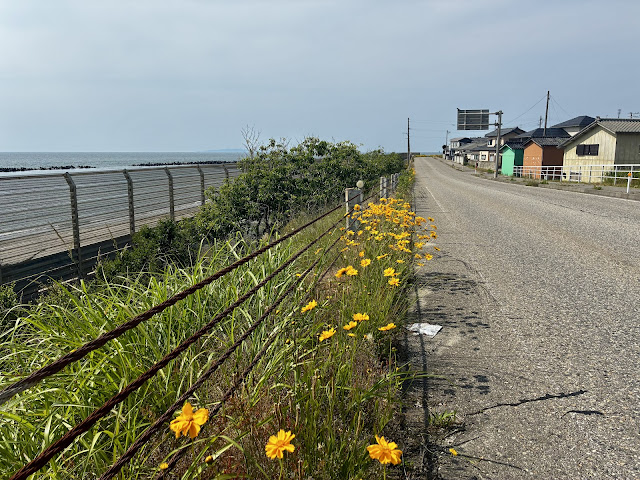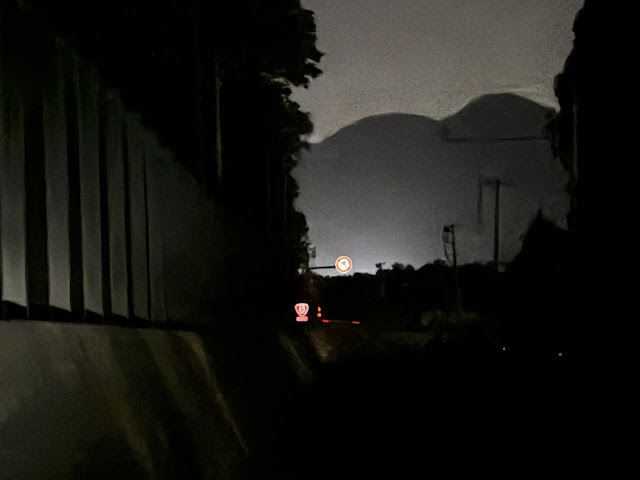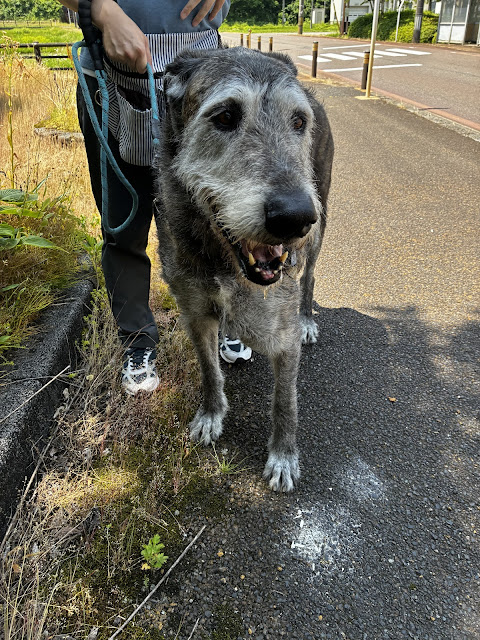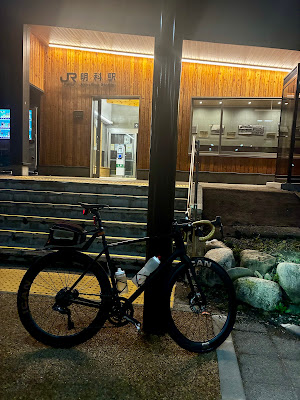 |
| Heading toward Aizu |
After a 300km+ attempt at the Aoba 600, plus a lovely Amariyama ride (1600m gain) and some shorter spins, it was time for my next 600km brevet. I hoped the recent efforts had my legs ready. Only one way to find out.
This was an Utsunomiya Audax event, starting and finishing in Tochigi (Yaita/Otawara). I used to ride their events often—signups didn’t fill up in 30 seconds like Saitama or Kanagawa. But since more Tokyo-area clubs popped up around 2015–2020, the appeal faded. The logistics were also a hassle: a long drive or awkward train + rinko combo, plus one time I had to pull off the expressway and nap in a parking area before driving home safely, as I was starting to close my eyes behind the wheel.
I hadn’t ridden with them since a gorgeous 2018 400km ride (east to Mito/Oarai, west past Maebashi) and a rain-soaked Choshi 400km in 2016. But this year offered a reason: my wife had discovered that the onsen water at a certain inn in Nasu Shiobara did wonders for her health. The inn has little else to recommend it but the onsen is special—if I did this ride, she got three nights there, and I got my ride and a recovery soak. A win-win.
The route looked terrific. No Tokyo sprawl, a double Honshu crossing, and a chance to peer toward Fukushima Dai-Ichi. The organizers warned of 8000m of climbing, but RidewithGPS said 7100m—and my watch logged 6600m. Still a proper challenge.
Only 14 riders started at 2AM Saturday. Among them was my friend Andrei O. We hadn’t coordinated, but I was glad to see him. He crashed the Japanese Odyssey podium last year and did PBP hours faster than I ever could. We go back to Fuji Hill Climb days and were together when I broke my collarbone descending a Gunma mountain in 2020. I didn’t expect to keep pace—just say hi.
 |
| My ride long after dinner with Andrei? |
I recognized a few others: Nagayama-san from the Iwaki 400km, some Chiba regulars. I introduced myself to one named Tsutsui-san, and to Sawamura-san, the only woman on the ride. At the start, Tanami-san (organizer) and Fujita-san (staff, maybe riding?) gathered us around for a briefing.
 |
| Participants unload their bikes from cars in the distance. |
 |
| Fujita-san is the rider with the explosion of hair. |
They did not do the bike checks until 2AM sharp. I was chomping at the bit (figuratively), as usual, and got out onto the course a few minutes later.
I was very happy with my pace on the first 50km of the event, which took me up the foothills then Shiobara keikoku in no traffic to over 800m elevation, the high point of the entire ride. A number of riders passed me, but I felt I was in the thick of the group, and was ahead of the clock. After the top of the second hill, we would basically descend or ride on the flat for 75kms.
 |
| These signs are everywhere in Fukushima prefecture. Are there actually flights from the airport? It seems far from anywhere! |
 |
| Making good time heading north to the west side of Aizu Wakamatsu. |
I reached the 162km control at 9:41AM, more than 3 hours ahead of the closing time. At this second control, a strong-looking guy in his 30s or early 40s was wrestling with a speed sensor, muttering "sai-aku" (最悪 - "the worst") over and over. Apparently, tunnel GPS glitches made him overshoot the first control by 7km. I told him things could be a lot worse—we had no rain, no cold, no headwind, and no traffic. If this was the worst, he needed a broader imagination.
As I went to discard my trash, I saw him casually smoking a cigarette. Only in Japan have I seen brevet riders lighting up mid-ride. Somehow, he still finished hours ahead of me.
 |
| Mr. "Sai-aku" and Fujita-san as we seek shade next to the PC convenience store. |
It got hot in the inland valleys—one roadside gauge flashed 31°C. After Aga, in the small town of Mikawa, I missed a turn off the national road onto a local one. I doubled back, scrambled down some steps, and rejoined the course. Under the overpass I’d just ridden, I sat on a bench to snack—only to meet a man walking the biggest dog I’ve ever seen. Calm and stately, the dog was part Great Dane, part Irish Wolfhound. He enjoyed the attention, but really wanted my egg salad sandwich. I apologized—no backup food and a long way to the next store. They forgave me. Next time, I’ll bring a spare sandwich for him.
My feet started to ache incredibly in my shoes, so I stopped beside the road and removed my second pair of thin cycling socks. That seemed to do the trick ... until the heat of the next afternoon. It got cooler once near the Sea of Japan, with a wind from the sea toward the land. I moved forward deliberately and at Murakami, 239kms, I was 3 hours 20 minutes ahead of the time limit. I ate and rested there, almost an hour. I never again managed to get 3 hours ahead of the time limit.
 |
| Sea of Japan |
 |
| Dragon in front of tourist info center at Senami Onsen |
The next stretch to Yonezawa included a slow climb to 350m on Route 113. Too much traffic, too many trucks, too many tunnels. Eventually I pulled off and lay beside a nearly dry gorge, cooling off a bit before continuing.
 |
| Passing into Yamagata ... did not end the climb. |
 |
| I rested here. |
At kilometer 304, we finally began descending into Yonezawa—though it turned out flatter than expected. I blew past the control, looking for a Family Mart, but it was a Lawson. A kilometer later, I pulled out my cue sheet, turned back, and found the right spot. A rider had even yelled to warn me as I passed. Sure enough, he was still there when I returned.
I’d ridden 332km, been out for 18.5 hours (20 including pre-start ride), and was still 3 hours ahead of the control close. I flopped onto the concrete outside the store and took a 45-minute rest.
The next segment would include a climb over mountains and then down to Fukushima-shi. The latter part of this segment I rode on the Fukushima SR600 in 2022. At least tonight we would NOT take Prefecture Route 232 through the woods to Toge Eki, but instead would use National Route 13. The climb from Yonezawa was just under 400m elevation gain. It was not so steep, and if fresh it would have been easy. I was not fresh, at all. So I was relieved to get to the tunnel at the top. I rode 2.5 km or more through a deserted, flat tunnel, then a quick descent about 100m vertical on the other side ... until a second flat tunnel of 2.5 kms, then a fast descent all the way to the edge of Fukushima-shi.
 |
| I am headed over (or through) that mountain to Fukushima-shi |
Our route crept along the hills to Iizaka Onsen Station. Jerome and I had stopped here last year when it was a control point on a Golden Week 1000km event. It was deserted this time, at midnight. I took a shorter rest and headed on, stocking up on food to snack on in the hills ahead.
 |
| Basho was here (Basho was everywhere) |
I reached the overnight control at 1:40AM—two hours and 20 minutes before closing. After a quick bite with Tanami-san and another staffer, I grabbed a bed in a four-bed room. Two beds were occupied, one vacated, and one—mine—fresh. A light eas on and the room was hot, but I was asleep in seconds, before 2am, and suddenly wide awake at 3:40. Downstairs, Andrei was getting ready to leave. Soon, Sawamura-san and another rider showed up—they’d already done 60km and 600m of climbing since midnight, as they had rested at Yonezawa. Machines.
I rolled out around 4AM, just as the control was set to close. Only 215km left. Easy, right? Well... I started strong. Andrei had vanished. I passed one rider, while Sawamura-san and the other sleepers were still behind. The route wound up and down before a 300m climb to a highland. New tunnels cut through the hills instead of roller coastering over them. The roads were pristine—Japan’s “throw-money-at-it” model results in great infrastructure, and they threw money here after the nuclear accident. If only tunnels cured population decline.
After the highland, a long descent led to the coast. I passed signs warning this was a “difficult-to-return” zone—帰還困難区域 being officialese for “wasn’t safe, still isn’t.” Side roads were blocked with steel pipes. Patrol cars cruised slowly. No humans out and about—just a troop of 60–80 monkeys darting across the road. The wildlife seemed fine. Maybe radiation’s long-term health effects are less brutal than living near human society. Or maybe they just haven’t read the research.
Later, I passed piles of irradiated soil, stacked in black bags along the roadside. Many more waited in nearby “temporary” storage sites. The contrast was stark: silence, sunlight, and all that dark plastic entropy.
 |
| Those cranes on the horizon are at Fukushima Dai-Ichi |
In Namie, near the coast, the town showed signs of re-occupation: new roads, fresh buildings, and vast open spaces. I stopped at a 7-Eleven—the cleanest convenience store toilet I’ve seen this year, and I’ve seen plenty. It was so immaculate I found myself brushing and wiping the toilet surfaces before I left. The staff—maybe a father and two teenage daughters—still had a COVID-era plastic sheet at the register. Polite, professional. No trash bins outside, and just one tiny receptacle inside for store-bought wrappers. I left them a glowing Google Maps review. Most reviewers whined about the lack of garbage cans, but really—if your neighborhood was surrounded by radioactive cleanup zones, would you want to take strangers’ trash?
The route headed south along the ocean, then veered inland past the destroyed nuclear facilities. Signs for “screening areas” and “difficult-to-return zones” were everywhere. Then the climbing began again—from sea level up to the highland at 500m. I was crawling. At one rest stop above a stream, I saw two older men fly fishing. One flicked his wrist and snagged a fish with delicate precision. We were 20km SW from the reactors, but here, life looked normal.
The next section was a climb up 100m, then down 300m -- generally a descent. Except even the descent included lots of nasty little up sections. They had not gotten any new tunnels here. The little climbs crushed my soul in the afternoon heat. My feet started to hurt. I took rests. On one, I lay down on a small spur that went up a hill. Along came another rider! He told me that I could still make it, and encouraged me. I swapped into thick wool socks—oddly, it helped, even if my shoes were now tighter than ever. I think from now I will always carry a variety of socks on these really long rides!
We rolled together at 20–25kph through farmland. The hardest bit was when we turned south into a stiff headwind across open fields. Then came a gradual climb toward the Fukushima–Tochigi border.
I asked the other rider’s name. “Fujita,” he said—one of the staffers I’d met in the dark 36 hours earlier. Back then, his wild, mad-scientist hair was unmistakable. Now, and yesterday at PC2, it was hidden under a cap. So I hadn’t recognized him. We kept each other company through the final stretches.
Once we got onto the real climb to the Tochigi border, I recognized the road from several brevets in recent years. I climbed stronger than I had the past 12-14 hours and got to the top well ahead of Fujita-san. I had 90 minutes left to go under 30 kms, and that started with a 10+km descent at high speed, another few kms with a very modest downhill, then a long trip across largely rural Otawara-shi. We took it easy the last 10km and still arrived with 10 minutes to spare. Half the riders finished in over 38 hours. The fastest time was 33:59. Second fastest was 35:51. So even if I was the slowest (I was, again, just like Iwaki) the difference was not very much.
I thanked Fujita-san profusely. If he had not come along, would I have given up? No. But would I have made it on time? I just don't know. I lacked confidence during a crucial segment between 530 kms and 570 kms. And riding with him was a great comfort. It was not until I was on the familiar climb to the Tochigi border that I smelled victory and got another spurt of energy.
After the "goal" we rode another 7 kms to the "reception" at bicycle shop Fleche in Yaita, near the start. My wife kindly picked me up and drove us back to the onsen inn. 627kms in total on the bicycle so I appreciated the ride.
I'm done with the full 200/300/400/600 series for 2025! I guess I still am a randonneur.



































































